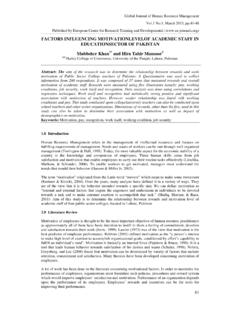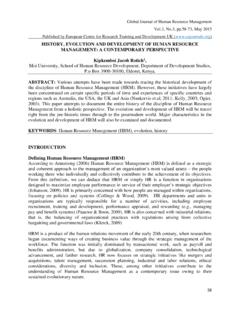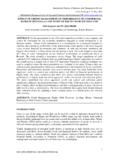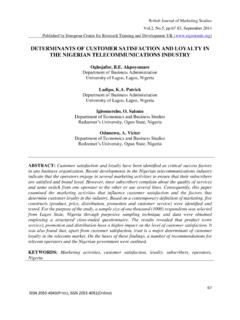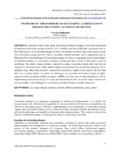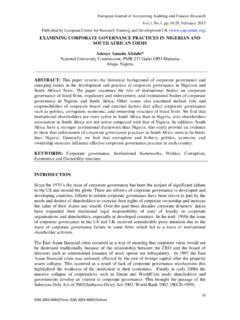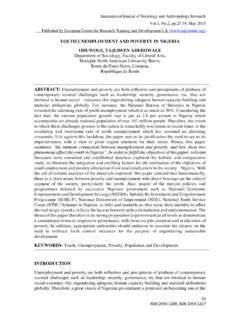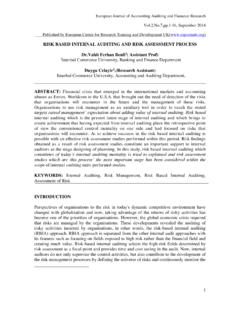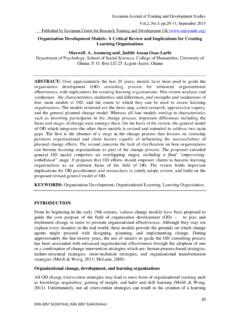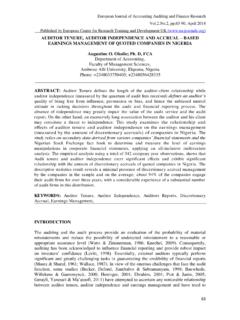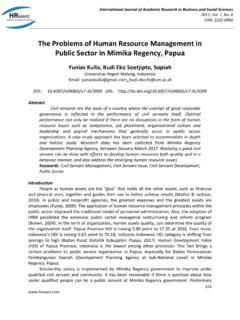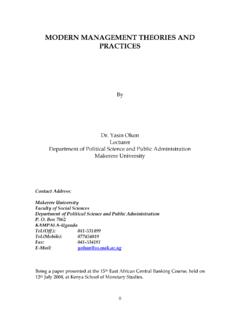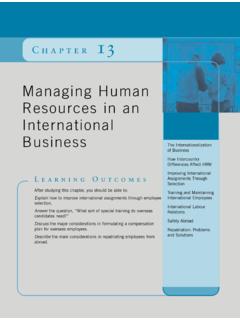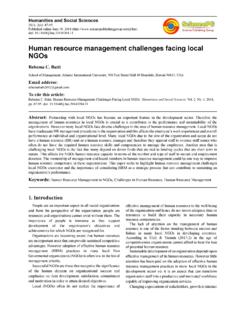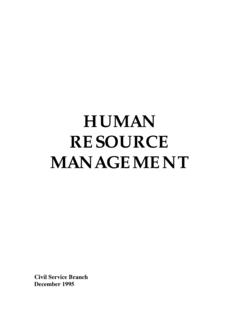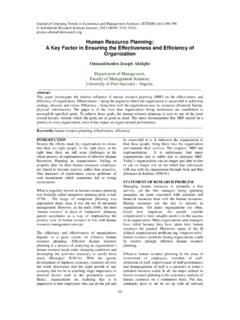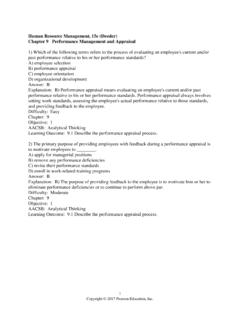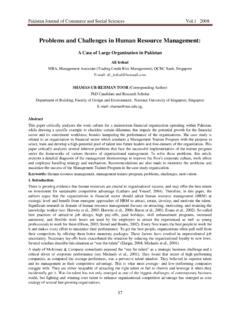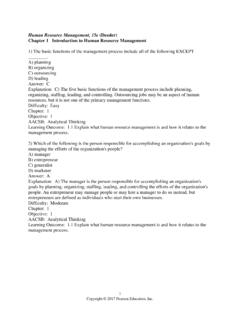Transcription of Global Journal of Human Resource Management …
1 Global Journal of Human Resource Management No. 2, pp. 1-12, March 2015 Published by European Centre for Research Training and Development UK ( ) 1 ISSN 2053-5686(Print), ISSN 2053-5694(Online) Human Resource Management AND PUBLIC ORGANIZATIONS Dr Naima YAHIAOUI1, Ahlem ANSER2 , Dr Samia LAHOUEL3 Faculty of Economic, commercial and Management sciences, Batna University, Batna, Algeria ABSTRACT: This research provide the most important foundations of Human Resource Management that we can apply in both public and private sector organizations such as job design, control, teamwork, leadership, managerial roles, staffing practices and career then moves on to review the process of HRM in private and public organizations, performance, functions in the PS, in addition to the operations of Human Resource Management in public sector, the main standards and its application, then we talk about the HR role in the public sector reform which is giving greater involvement in public sector in order to improve services.
2 KEYWORDS: Human Resource , Management , public organizations, process of HRM, performance. INTRODUCTION Efficiency of administration is directly depending on Human resources, therefore we need to develop our public institutions through modernizing and improving Human Resource Management by building up efficiency of individuals and improving theire performance. Therefore Algeria draws intrest to this important Resource through the rehabilitation of administration and making it citizenship and activating the transparency, responsibility, accelerate the response to the concerns of citizens, and provide services with best quality and lowest cost Problematique: How can we exploit Human Resource in public sector? From this main question we ask the following sub-questions: What is Human Resource Management ? What are the operations of Human Resource Management in the public sector? Importance of the research: Importance of this research is knowing the operations that we need to incorporate in Human Resource Management for public sector development.
3 Research goals: This research aimed to Highlighting the need to develop Human Resource Management . Identifying Human Resource Management operations in the public sector. Showing the standards of Human Resource Management in public sector. Structure of the resourch: The Resource includes three main axes: 1_ Human Resource Management . Global Journal of Human Resource Management No. 2, pp. 1-12, March 2015 Published by European Centre for Research Training and Development UK ( ) 2 ISSN 2053-5686(Print), ISSN 2053-5694(Online) 2_ Human Resource Management in public and private organizations. 3_ operations of Human Resource Management in public sector. 1_ Human Resource Management : The roots of HRM go back as far as the 1950s, when writers like Drucker and McGregor stressed the need for visionary goal-directed leadership and Management of business integration .This was succeeded by the behavioural science movement in the 1960s, headed by Maslow, Argyris and Herzberg.
4 These scholars emphasised the value aspect of Human resources (HR) in organisations and argued for a better quality of working life for workers. This formed the basis of the organisational development movement initiated by Bennis in the The Human Resource accounting (HRA) theory developed by Flamholtz (1974) was an outcome of these sequential developments in the field of HRM and is considered to be the origin of HRM as a defined school of thought. HRA emphasised Human resources as assets for any organisation. This asset view began to gain support in the 1980s. The last twenty-five years or so have then witnessed rapid developments in the field of HRM, which are an outcome of a number of factors such as growing competition (mainly to US/UK firms by Japanese firms), slow economic growth in the Western developed nations, realisation about the prospects of HRM s contribution towards firms performance, creation of HRM chairs in universities and HRM-specific positions in the industry, introduction of HRM into curricula in the early 1980s, and a continuous emphasis on the involvement of HRM strategy in the business The definition of Human Resource Management : All planned and controlled activities of an organization to build and maintain the relation between employees and the organization in order to meet both buseness objectives and employees Other definitions: HRM is a process for staffing the organization and sustaining high employee performance.
5 HRM can be defined as all the practices , systems and procedures implemented to attract, acquire, develop and manage Human resources to achieve the goals of an organization. Simply it is managing the employment Foundations of Human Resource Management : We will briefly review the most important foundation in HRM:5 1 _ job design and control: Traditional forms of work organization are based on the division of work. As such, they require jobs to be analysed and designed along strict lines of demarcation and then grouped into separate functional units. With time jobes can be enlarged so that specialist can be more responsible for an increased number of tasks to avoid rigid job demarcation. Control operates in the traditional work organization through direct observation , limited feedback, personel supervision, collection of progress reports, and formal performance 1, 2 : 3 : 4 : 5 :Carlos Senchez_Rund, Richard Whatington, Javier quintalla, HRM implications of new forms of organizing, Spain, 2000,p : 04.
6 Global Journal of Human Resource Management No. 2, pp. 1-12, March 2015 Published by European Centre for Research Training and Development UK ( ) 3 ISSN 2053-5686(Print), ISSN 2053-5694(Online) evaluation, the new way of control is put employees in charge by exercising broad judgment and employee self-discipline. 2_ Team work, leadership, and the managerial roles: 2_1. Teamwork: Work in team, while scarce in the traditional approach to work organization and dominates the new organizational arrangements. Team memberse manage there own resources( planning, scheduling, co-ordination with other ).1 2_2. Leadership: Goals of organization cannot be accomplished unless accompanied by new views on leadership. On the one hand, traditional leader inspired, controlled, supported and facilitated utilisation of employee functional expertise by means of limited participation in routine matters, On the other hand, new leaders are expected to broaden responsabilities of all organizational members by investing in employee development, so that people aquire strategic and change expertise Leadership 2-3.
7 Managerial roles: New managerial roles need to be learned by the members of the organization. Traditional roles themselves evolved from what metaphorically have been described with the labels of policemen to father figures to mentor keeping employees focused on their prescribed assignment to evokes the figures of catalysts, architects, and 3_ The new pcychological contract: The link between what each party expests from other usually referred to as the pcychological contract , has been recently revised in the light of downsizing experiences and new forms of work organization because managing several sets of contract within the same firm incrise the pressure on the consistency of HRM practices across the Frequente changes in the patern of work organization demande high doses of flexibility , which translates into new agreements with the employees. 4_ Staffing practices: Today s organizational requires are maintaining demands and the set of knowledge, skills, and abilities that will be needed tomorrow, that is why recruitment and selection are seen as means to build up a diserve pool of personal capabilities from which changing needs may be satisfied in the 5- career Management : The new career systems grow closely linked to the changes in the organization of work and the new teamwork and leadership requirements discussed above.
8 Those new systems center around the following characteristics:6 Knowledge Based specialization baseline cross-functional expertise collaborative leadership 1 : Hedlund, model of knowledge Management and the new form corporation strategic Management Journal , 1994, p : 84. 2 : Handy C. The new language of organizing and its implications for leaders. San Francisco, 1996. 3 : Miles & snow. Fait failure and hall of fame, New York, free press,1994. 4 : Rousseau D. Psychological contracts in organizations understanding written and unwriten agreements, Inovating organization, London, 1995. 5 : Hastings C, The new organization, Growing the culture of organizational networking, London, 1996, p 28. 6 : Snow & miles, 1996. Global Journal of Human Resource Management No. 2, pp. 1-12, March 2015 Published by European Centre for Research Training and Development UK ( ) 4 ISSN 2053-5686(Print), ISSN 2053-5694(Online) self- Management skills along with of flexibility, trustworthiness, and integrity and developed reward system focusing on potential for reinforcing the new forms of organization.
9 2_ HRM in public and private organization: Prior research of HRM in private and public organizations gives a contradictory view of similarity versus dissimilarity. On the one hand, the traditional ideology pronounces a need for similarity between the two sectors. The similarity hypothesis based on institutional theory claims that public sector organizations adopt similar HRM practices to those of the private sector in order to gain legitimacy in regard to the demands for increasing cost-effectiveness. On the other hand, organizations in the public sector are still seen to represent a softer model of Management and HRM with an emphasis on operational activities and a reactive role in relation to Public sector organizations are distinguished in three main ways from the private companies: ownership (members of political communities vs entrepreneurs or shareholders), the source of funding (taxation vs customers) and control (political vs market forces).
10 Public sector HRM is seen to be associated with softer norms and the ideal of model employers thus setting standards, such as training and equal opportunities in the workplace, and it is seen to differ from the hard (more formal and calculative ) mode of HRM in the private sector . Most of the existing HRM studies focus on private companies or large organizations without specifying the sector they represent. The study of public sector organizations has played a marginal role, and the results are inconsistent. For example, uncover significant differences between public and private sector organizations in HRM policies and practices, while the results reported by refer to similarities between the two sectors, and reveal both similarities and differences. Furthermore, as mentioned in the previous section, studies have neglected to explore such differences and similarities within societal As part of strategic HRM research, the relationship between HRM and organizational performance (HRM-P) has been widely discussed and studied in prior literature, mostly in the private sector 3 The performance measures applied in HRM-P studies range from objective figures to a variety of subjective performance evaluations.
